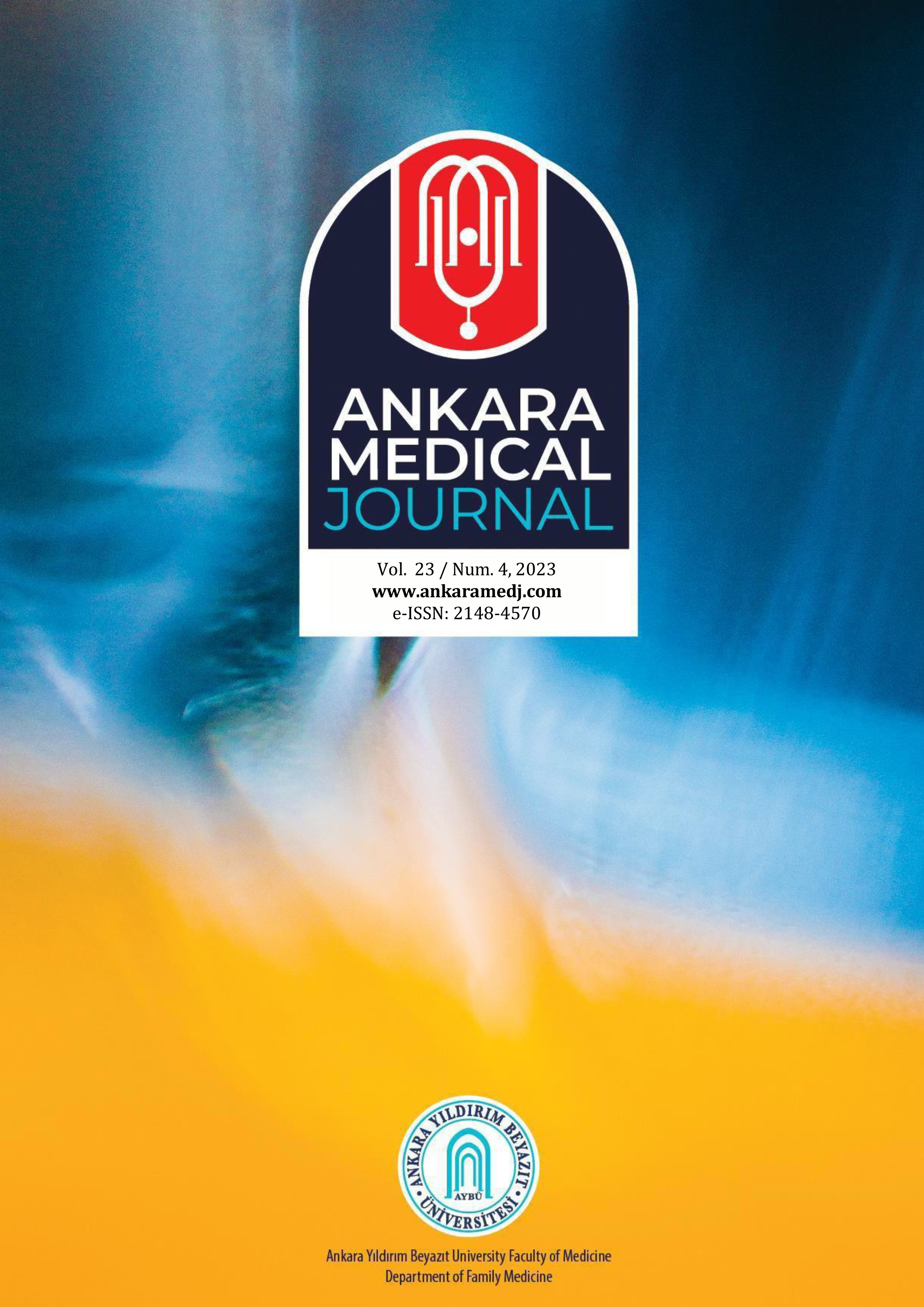E-ISSN: 2148-4570 ISSN:2148-4570
Volume: 23 Issue: 4 - 2023
| ORIGINAL ARTICLE | |
| 1. | Geographical Distribution and Trends of Women Breast Cancer Mortality in Turkey Between 2009-2019 Nurhan Doğan, İsmet Doğan, Dilek Toprak doi: 10.5505/amj.2023.45549 Pages 366 - 377 INTRODUCTION: Breast cancer is the most common malignancy in women all over the World. It is in the first line, causing deaths because of cancer in women worldwide. However, its progress differs regarding the counties socioeconomic and cultural features. The aim of this study is to estimate breast cancer mortality rates in Turkish women by geographic region and to evaluate 11-year mortality trends. METHODS: Joinpoint Regression Analysis was used to estimate the trends of mortality from breast cancer by gender and age groups for every geographic region. Also, we used the world standard population (100,000 women) was used to estimate the age-standardized mortality rates as a reference to calculate age-standardized mortality rates. RESULTS: We found that nearly 39,000 women died from breast cancer between the years 2009-2019. During this 11-year period, the age-standardized mortality rate in Turkey was 6.84 per 100,000 women in 2009, while it rose up to 8.16 in 2019 with a significant increase of 1.78 per year (Confidence Interval: 0.57: 3.00) p=0.009). This change was observed especially in TR2, TR7, TR9, TRA, TRB and TRC regions. According to the age groups examined, significant increases were observed in all age groups in Turkey. DISCUSSION AND CONCLUSION: Breast cancer is still a very important health problem in Turkish women of all ages. It is essential to take measures to reduce the breast cancer mortality rate and increase early diagnosis opportunities in our country. |
| 2. | Is the risk of malnutrition among caretakers related to caregiver anxiety? Ayşe Naciye Erbakan, Özge Telci Caklılı, Özlem Gönen, Banu Mesçi, Aytekin Oğuz doi: 10.5505/amj.2023.73558 Pages 378 - 388 INTRODUCTION: This study aims to investigate the association between caregiver anxiety and the risk of malnutrition among caretakers. METHODS: A total of 200 caregivers whose patients were hospitalized in internal medicine clinics were included in a cross-sectional study. Patients were screened with the Nutritional Risk Screening (NRS) 2002 and divided into two groups: Patients with scores <3 (patients without nutritional support) and with scores ≥3 (patients with nutritional support). Caregiver distress was assessed using the State-Trait Anxiety Inventory (STAI). RESULTS: Anxiety scores were high for all caregivers (mean state anxiety score 42.4 (min=20, max=70, median=42) and median trait anxiety score 41 (min=25, max=64, mean=41.4). However, the anxiety scores of caregivers of patients with malnutrition did not differ from those of caregivers of patients without malnutrition( for NRS score < 3 versus ≥3, state anxiety score 41.4±10.1 versus 42.7±10.1, p=0.428, and trait anxiety score 40±12 versus 41±13, p=0.494, respectively). Caring for patients for more than one year without support or with minimal support was significantly associated with higher anxiety scores compared to caring for more than one year with support or caring for less than six months without support (for state and trait anxiety, 50.4±9.1 vs 41.0± 9.7, p < 0.001 and 49±10 vs 40±12, p < 0.001, respectively). DISCUSSION AND CONCLUSION: The absence of a support system and the duration of caregiving were found to be associated with an increased risk of caregiver anxiety, especially when both factors were present. However, no effect was observed on malnutrition status based on levels of anxiety among caregivers. |
| 3. | Care Burden and Influencing Factors of Elderly Patients Receiving Home Health Care: Perspectives of Patients and Caregivers Ersan Gürsoy, Salih Eren doi: 10.5505/amj.2023.63549 Pages 389 - 399 INTRODUCTION: The aim of the study was to determine the care burden and influencing factors of patients receiving home health care. METHODS: The study was cross-sectional descriptive and was conducted with patients who benefited from a tertiary hospital's home health care unit. A 25-question demographic data questionnaire was prepared by the researchers by scanning the literature, and the BARTHEL daily living activities index was applied to the patients. RESULTS: A total of 416 people participated in the study, 34.86% (n=145) of whom were male, and 65.14% (n=271) were female. According to the Barthel daily living activities index, 43.75% (n=182) of the patients were entirely dependent, 38.46% (n=160) were severely dependent, and their average score was 34.14±29.27. No significant relationship was found between the gender of the caregiver, closeness with the patient, education level of the patient and the perceived burden of care. On the other hand, a significant relationship was found between the education level of the caregiver, the profession, the dependency degree of the patient, and the perceived burden of care (p=0.001, p=0.031, and p<0.001, respectively). DISCUSSION AND CONCLUSION: To reduce the care burden of caregivers, it is necessary to increase the quality and accessibility of home healthcare services, provide education and support for patients and caregivers, and take measures to maintain and improve patients' independence. |
| 4. | The Relationship Between Smartphone Addiction Levels and Psychological Symptoms and Sleep Quality Among Medical Students Muhammet Özmen, Kamile Marakoğlu, Muslu Kazım Körez doi: 10.5505/amj.2023.26594 Pages 400 - 414 INTRODUCTION: In this study, it was aimed to determine the level of smartphone addiction in medical students and its relation to some psychological symptoms and sleep quality. METHODS: The research data were composed of four parts. A sociodemographic data form consisting of 30 questions was prepared by the researcher, including the Smartphone Addiction Scale-Short Version (SAS-SV), the Brief Symptom Inventory (BSI), and the Pittsburgh Sleep Quality Index (PSQI). RESULTS: According to the evaluation made by considering the cut-off points of the SAS-SV, 34.41% of the students were found to be at risk of smartphone addiction. SAS-SV scores were highest in those who used their smartphones for eight hours or more daily and those who checked their smartphones 51 times or more in a day. The highest risk of smartphone addiction was found among those who left their phones in bed or under the pillow at night, those who checked their phones within one minute after waking up in the morning, and those who charged their smartphones more than once daily. Students' BSI three global indices and median scores of all sub-dimensions were higher in those at risk of smartphone addiction. In addition, significant positive correlations were found between the SAS-SV scores and the PSQI total scores. DISCUSSION AND CONCLUSION: The results indicate that psychological symptoms and sleep quality are associated with smartphone addiction. This may lead to depression and/or anxiety, which can consecutively result in sleep problems. Responsible use of smartphones may have a positive effect on students mental health and sleep. |
| 5. | Improving Female Students Physical Fitness Index May Reduce Cardiovascular Risk Desy Nofita Sari, Fathiyyatul Khaira, Rahmani Welan, Atika Indah Sari, Desmawati Desmawati doi: 10.5505/amj.2023.67503 Pages 415 - 427 INTRODUCTION: Evidence suggests that lower cardiovascular disease risk is among the most important factors for decreasing premature mortality rates in non-communicable diseases. Physical fitness is a potentially important factor for cardiovascular disease prognostication. We aim to analyze the correlation between physical fitness and the risk of cardiovascular disease in female students. METHODS: 76 participants completed all examinations. Cardiovascular disease risk factors were assessed by measuring body fat percentage, blood pressure, and lipid profiles. Physical fitness was measured using the modified Harvard step test to compute the physical fitness index., Spearman correlation was used to determine the correlation between variables in this study. RESULTS: A negative correlation between physical fitness index with body mass index, fat percentage, systolic blood pressure, and diastolic blood pressure (r = -0.443; r = -0.409; r = -0.370; r=-0.280). We also found that the physical fitness index did not significantly correlate with the lipid profile. DISCUSSION AND CONCLUSION: The physical fitness index might predict individual cardiovascular disease risk. Physicians should encourage patients to exercise regularly to maintain or improve their fitness levels to prevent cardiovascular disease. |
| 6. | Comparison of health-related quality of life between dialysis patients and kidney recipients Marzieh Latifi, Elahe Pourhossein, Habib Rahban, Azadeh Sadatnaseri, Maryam Rahbar, Sanaz Dehghani doi: 10.5505/amj.2023.17092 Pages 428 - 440 INTRODUCTION: Health-related quality of life (HRQOL) assessment is important for patients with end-stage kidney disease. This study aimed to determine the contribution of demographic factors to HRQOL in affected kidney recipients and dialysis patients on the waiting list for kidney transplantation in Iran. METHODS: This was a comparative survey. We required 196 patients in the Sina Organ Procurement Unit. HRQOL of 100 kidney recipients was measured using Study Short-Form 36 and compared with 96 dialysis patients. The factors investigated were age, gender, and cause of kidney failure; data were evaluated using SPSS 16.0 software. RESULTS: The scores of both groups were ordered from high to low in the following three dimensions: physical functioning, emotional well-being, and vitality. The mean physical component scores in kidney recipients and dialysis patients were 14.44±4.32 and 5.91±4.60, respectively. The mean mental component summary scores in kidney recipients and dialysis patients were 5.91 ± 4.60 and 5.12 ± 2.11, respectively. There were significant differences in all domains of HRQOL except role limitations due to emotional problems and emotional well-being in both groups (t = 0.963, P = 0.420). Age made the largest unique contribution (β = 0.211) to the physical component, while marital status was the greatest contributing factor to the mental component. DISCUSSION AND CONCLUSION: HRQOL improved after successful kidney transplantation compared to dialysis patients, despite kidney transplant patients suffering the effect of using immunosuppressive medicine and being subject to infectious complications and tumors. This study shows that we have reached the primary goal of transplantation, which is to improve the HRQOL of kidney recipients. |
| 7. | Assessment of Physiological and Psychological Dependence on Tobacco Mert Bardakçı, Serdar Öztora doi: 10.5505/amj.2023.39225 Pages 441 - 454 INTRODUCTION: Smoking is recognized as the most important preventable public health problem in the world with known carcinogenic, mutagenic and addictive effects on many organs and systems. METHODS: Our study was conducted with 380 first-year students of Trakya University who were tobacco users in the 2020-2021 academic year. The 62-question questionnaire included questions about socio-demographic characteristics and smoking, as well as the 6-question Fagerstrom Nicotine Dependence Test (FTND) and the 25-question Test to Assess the Psychological Dependence on Smoking (TAPDS). RESULTS: Our study consisted of 185 male (48.69%) and 195 female (51.31%) students. Of the participants, 94 (24.73%) were from health-related faculties and 286 (75.27%) were from non-health-related faculties. It was observed that 364 (95.78%) of the participants smoked cigarettes and 16 (4.22%) used non-cigarette tobacco products. When the participants were classified according to their FTND scores, the most crowded category was very slightly addicted with 210 participants (55.27%), while the most crowded category was moderately addicted with 190 participants (50%) according to their TAPDS scores. It was also observed that using cigarettes as a tobacco product, having a smoker in the family and living alone at home made a statistically significant difference for both physical and psychological addiction. In our study, it was determined that there was a statistically significant, linear, same-directional and moderate relationship between physical dependence and psychological dependence. DISCUSSION AND CONCLUSION: In order to better understand the factors affecting smoking addiction and to make individualized treatment selection, it is important to differentiate between physical and psychological addiction. |
| REVIEW | |
| 8. | Historical aspects of non-alcoholic fatty liver disease: studies and classifications Alla Kireeva, Natalia Konyshko doi: 10.5505/amj.2023.39129 Pages 455 - 467 Non-alcoholic fatty liver disease (NAFLD) is one of the most common liver diseases worldwide and is currently the second leading indication for liver transplantation. The global obesity pandemic is linked to metabolic syndrome, so the prevalence of NAFLD will increase progressively and become a real burden on the economy and public health worldwide. Assuming that assessment of the history of a disease can improve clinical practice and provide efficient clues for research, the aim of this article is to review the background of nonalcoholic fatty liver disease (NAFLD) in adults and children. We have reviewed the evolution of the definition and classification of NAFLD as a distinct nosological form and started our consideration with the year 1836. The review performed covers the first guidelines issued by the scientific community throughout current clinical guidelines. We have also considered diseases associated with this pathology, from early steps to more recent studies confirming that NAFLD is a risk factor for cardiovascular disease, hepatocellular carcinoma, and other malignancies. This article discloses current differences in the International Classification of Diseases (ICD) 10 and ICD 11. In the updated ICD 11th revision, NAFLD is presented as a separate heading (DB92 - nonalcoholic fatty liver disease), which is closer to modern nomenclature. This classification allows a better understanding of research and clinical approaches to the diagnosis, treatment, and prevention of the disease. |
| 9. | Viral hepatitis B and C and neurological impairment Tatyana Vasiliyevna Polukchi, Yelena Alekseevna Slavko doi: 10.5505/amj.2023.73483 Pages 468 - 477 Viral Hepatitis B and C are characterized as systemic diseases with a wide range of extrahepatic manifestations caused by various immunological disorders. Neurological disorders are among the most important extrahepatic manifestations, which can serve as indicators of the presence of viruses and play a major role in the clinical picture of the disease. This review article describes the most frequently manifested neurological disorders detected in patients with chronic viral hepatitis, particularly Hepatitis B and C. |






